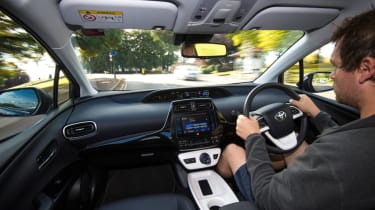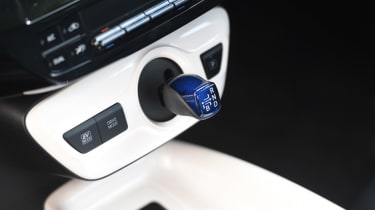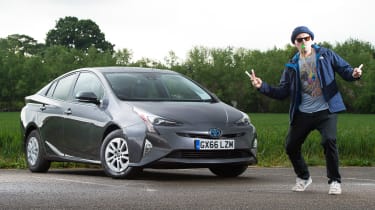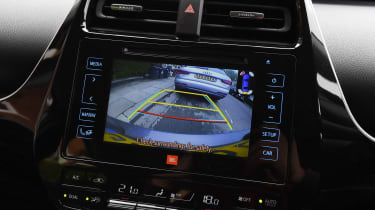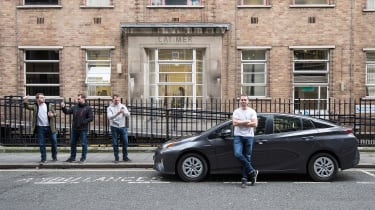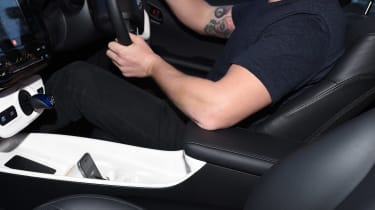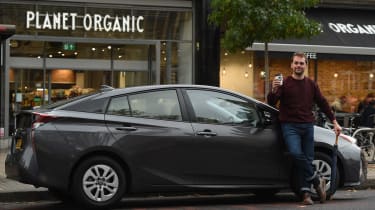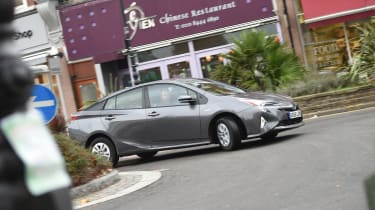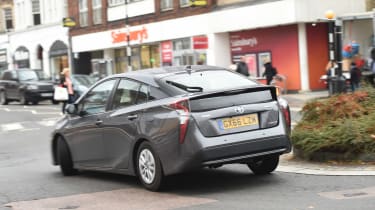Long-term test: Toyota Prius (2015-2022)
Final report: we say farewell to the car that gave us a relaxing start to every day
While the image of the Toyota Prius suggests that it might put you to sleep, the reality is much different. I’ve loved getting into our Toyota every morning, thanks to its comfortable ride and quiet powertrain. It’s even been perfect for doing long distances, as well as city commutes.
Mileage: 12,253 Economy: 63.4mpg
All good things have to come to an end. That’s true of our time with the Toyota Prius, which has sadly left our fleet – but it’s also true for me, every morning.
At 5:30am each day, my alarm goes off, and I’m forced to drag myself out of bed and end a good night’s sleep early. Even after years of doing it, I’ve never managed to get used to these crack of dawn starts – but for the past 12 months, it has been made a hundred times easier by the Toyota Prius on my driveway.
My daily commute is different every day, as I travel around the country to take many of the pictures you see in Auto Express, but the Prius is so comfortable and tranquil that it makes even the longest journey much more simple.
I could be on the M1, A34 or M25 with people tailgating me, lane hogging and not understanding how variable speed cameras work – but in the Toyota it somehow doesn’t seem to bother me as it used to. The adaptive cruise control and minimal wind noise ensure it’s calm on a long journey.
Used - available now

2020 Toyota
Prius
34,796 milesAutomaticPetrol1.8L
Cash £16,100
2020 Toyota
Prius
50,351 milesAutomaticPetrol1.8L
Cash £17,800
2020 Toyota
Prius
44,951 milesAutomaticPetrol1.8L
Cash £19,911
2018 Toyota
Prius
52,000 milesAutomaticPetrol1.8L
Cash £12,500Or I could be coming into our office in central London on congested city streets. The relaxed CVT gearbox and hybrid powertrain mean the Prius glides along silently for most of the trip at low speed, so even in traffic my stress levels don’t rise too much.
Then there’s the inevitable morning where you get into your car and remember that you need to fill up with fuel. The Prius is still combustion-engined, but the hybrid system means that happens much less often. We’ve managed 63.4mpg over our time with the car, which is an incredible real-world figure and it was achieved without me driving particularly gently. It’s testament to how well Toyota’s hybrid system works, and I’m more than happy with how fuel efficient the car has been.
However, there are a few niggles with the Prius that have got on my nerves over the past year, and the main one is how much it beeps at me. It chimes when I’m reversing, or if there’s a speed camera coming up ahead. It’s good to be warned of potential hazards, but the constant beeping and bonging did become a bit irritating.
The 343-litre boot isn’t as spacious as I’d like with all my photography gear in the back, although admittedly it did all fit in well enough. And with 1,558 litres of space with the seats folded down, there was actually loads of room if I did need to squeeze anything bigger inside.
Then there’s the taxi-driver image our metallic grey model projects. I’m not too worried about being misidentified as a minicab, but I can’t deny that, especially on our car’s energy-saving 15-inch wheels, the Prius does look a little dull, even when you factor in futuristic styling details like the pointy nose and LED tail-lights.
The interior could be a bit more luxurious, but other than there not being enough adjustment on the steering wheel, it’s ergonomically very good. The driving position is comfy, and you sit low in the cabin without compromising visibility.
Still, there’s little to complain about overall with the Toyota, and I’ll genuinely miss having it around. The lightweight controls, comfortable ride and excellent refinement meant I’ve rarely felt stressed, and there’s even some fun to be had when I arrive at some of the great driving roads we use on our tests.
Toyota Prius: third report
The Toyota Prius hybrid is a great all-rounder, but constant beeping reminds our man of a rave
Mileage: 9,636Economy: 57.8mpg
I’m getting on brilliantly with the Toyota Prius – mostly. I love the impressive efficiency, the practicality and the relaxing cruising, but there’s one thing that frustrates me with this ultimate green machine: the incessant beeping the car makes when you do just about anything.
There’s more beeping and bonging than a dance track. It makes me think I’ve made a return to my raving days, complete with Kevin and Perry-style bucket hat, glow sticks and party whistles. Let me go into a bit more detail.
As Auto Express’s staff photographer, I often use the Prius for taking pictures. This either involves driving along sat in the boot with the enormous hatchback open, or shooting out of one of the side windows, depending on the type of picture required.
With the boot open, the moment you set off the car starts beeping and chiming. Now I accept it’s a safety feature – so it’s worthwhile to have an audible reminder that the boot isn’t properly latched – and that most people won’t use the car this way. But it goes even further.
In normal circumstances, if you push the EV button to go into electric-only mode, the car beeps. If I pull over to stop and open the door with the ignition on, the car beeps. If I leave the ignition key in the car, it beeps. It beeps at me when I’m approaching a speed camera, and it beeps at me when I’m getting close to a solid object when reversing.
• Toyota Prius vs Hyundai Ioniq
Again, I know these features have all been developed for the benefit of the driver, but the shrill, aggressive tone that’s emitted in all these situations goes right through me.
The real frustration is that the Prius has otherwise been a perfect long-term companion. I’m enjoying how relaxing it is to drive not only in town, but even over long distances where the old car was never in its comfort zone. The low levels of wind noise are impressive, while the powertrain is more muted than before and is less likely to send engine revs soaring if you need extra power.
A long journey to Newcastle a few weeks ago reinforced to me and a car full of friends how versatile the Toyota is. The 343-litre boot swallowed everyone’s luggage easily, there was plenty of space inside, the infotainment system kept us occupied on the move thanks to our Excel model’s JBL hi-fi, and the CVT gearbox and relatively refined engine meant smooth cruising, while there was no need to stop for fuel.
I live in North London and spend plenty of time pootling around the city as well as travelling to the four corners of the country to bag the best pictures for Auto Express. It means the Prius covers plenty of mixed miles and I’m really impressed with the 57.8mpg it’s returning overall.
We had a new plug-in Prius on test recently, and after the mains electricity-filled battery range was depleted, my standard Prius hybrid wasn’t too far behind it in terms of real-world fuel economy. Better still, you don’t have to remember to plug the car in or even find a vacant charging point, and it’s a whopping £3,050 cheaper in top-spec Excel trim even after the plug-in car’s Government grant.
Plus, the smaller battery pack in my car compared to the battery in the Prius PHV means there’s 152 litres more load space, making it more practical, too.
I was thinking of the Toyota’s virtues on the drive to Newcastle, and I’d almost forgotten about the blood-boiling beeping – and then it started again as I parked up....
Toyota Prius: second report
The Toyotas Prius is a favourite of Uber drivers, and it’s easy to see why
Mileage: 5,640Economy: 56.5mpg
The rise of ride hailing app Uber has also seen more and more Toyota Prius land in the UK. Auto Express went behind the scenes to see exactly what it takes to be an Uber driver recently, but one thing is for sure: you need a Prius.
I mean that in a positive way, because our long-term Toyota has proven a brilliant companion recently, and I’ve experienced exactly what it’s like to drive a Prius around London over the last few weeks.
First of all, it took me a while to work out why people were waving their iPhones at me whenever I was waiting at a major junction or a set of traffic lights. It only then dawned on me as they wandered over to the Prius and yanked at the door handles that they thought I was their cab.
However, when it comes to ferrying friends around, the Toyota is brilliant. If I was to become an Uber driver for real, there’s no doubt my taxi of choice would be a Prius. There’s loads of space inside across the rear bench, and the 343-litre boot ensures it can carry everyone’s luggage, too – or in my case, a load of camera gear.
• How to get a job as an Uber driver
The tall sidewalls of the tyres help the Prius’s already forgiving damping, so the ride is cushioned and controlled. It makes for relaxed progress on the road, which is why the din you get from the rear of the cabin on the move is a little frustrating. However, this is only really highlighted by the refined powertrain, as around town I find myself cruising on electric power alone more than I thought I would. Hence the car’s impressive 56.5mpg so far.
It’s a shame, then, that in stop-start traffic the brakes are a little grabby. Presumably it’s the switch between the electric motor acting in reverse to slow the car and the discs and calipers fully bringing it to a halt. It smooths out at higher speeds though, so you just have to be a little more careful with how you apply the pedal at lower speeds.
Back in the cabin, the big central bin between the front seats gives a very useful storage area for odds and ends, but it’s at an awkward height.
It means my left arm has to hover above the armrest in an unnatural position, rather than leaning on it, which would be more comfortable. This is one of the very few complaints I’ve had with the Prius so far, though. It’s not hard to see why it won our Best Green Car award last year and has dominated in road tests against its eco-focused rivals.
Grey wouldn’t be my colour choice, though, as it further forges the impression I’m an Uber driver. But that’s not necessarily the Prius’s fault – it’s a sign that it can carry people in comfort around urban environments better than anything else.
Toyota Prius: first report
Can class-leading Toyota Prius hybrid turn our man into a fully fledged, organic eco warrior?
Mileage: 1,067
Economy: 58.2mpg
The car you drive gives off all sorts of messages. Bystanders will, rightly or wrongly, make assumptions as to what sort of person you might be and the lifestyle you might lead, simply based on the make and model of car upon which you choose to spend your hard-earned cash.
However, at Auto Express, we get to experience many different vehicles, both on short-term road tests and by living with them for a longer period of time. As a result, I frequently wonder how other motorists perceive me when I’m behind the wheel of something new. I often look like I could either be on the school run or playing for one of London’s many lower-league football teams, depending on what keys I happen to be holding at the time.
So when I was informed I’d be running the latest addition to the Auto Express fleet, the Toyota Prius, my mind didn’t have to work too hard to figure out what the car would suggest about me. Or so I thought…
The Prius needs no introduction – it’s our favourite green car, and has seen off the challenge from rival hybrids such as the Kia Niro and Hyundai Ioniq. It’s an eco car for eco-conscious people, and as I live in Highgate, north London, a stone’s throw away from trendy Muswell Hill and Hampstead Heath, it should fit right in.
• Best low emissions green cars
I’m surrounded by free-range, organic and Fairtrade retailers. These businesses and people care about our environment, so with the Prius’ claimed 85.6mpg, the petrol-electric powertrain should be welcomed with open arms. On the other hand, though, with the rise of the app-based taxi service Uber, and the Uber driver’s love of the eco machine, people might simply think I’m moonlighting as a minicabber. Only time will tell.
Whatever messages the Toyota gives off, there’s more to this environmental warrior than meets the eye. Our car is a £27,755 top-spec Excel, so there’s plenty of equipment – heated leather seats, wireless phone charging, head-up display, sat-nav, a JBL sound system, LED lights and parking sensors are all included as standard.
Toyota’s Safety Sense pack also features. This includes autonomous braking with pedestrian detection, adaptive cruise, lane-departure warning with rear-cross traffic alert and high-beam assist.
One option we’ve chosen to change are the wheels. While 17-inch alloys are the norm, if you swap these for the 15-inch rims, the price comes down by £400, plus the car’s CO2 emissions drop from 76g/km to 70g/km. This means the Toyota becomes Congestion Charge exempt, which will be a big boon as Auto Express’ office is located inside the central London C-Charge zone.
The smaller wheels also improve the ride quality without adversely affecting handling – and as our latest road test versus the Ioniq showed, the Prius is good fun to drive.
I cover a great many miles every week, so while I’ll be exploring the hidden depths of the Toyota’s chassis, as staff photographer, my major focus will be on maximising efficiency with the car loaded up with my equipment. The Prius has already proven practical and efficient in the short time I’ve had it, so the signs are positive.
And when it comes to the image my car portrays about me, I’m hoping I’ll stick to eco champ rather than Uber driver.


